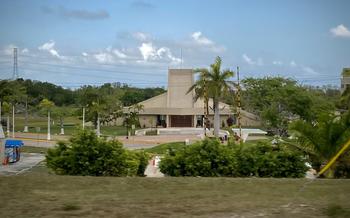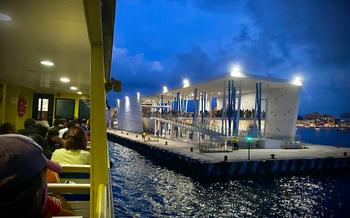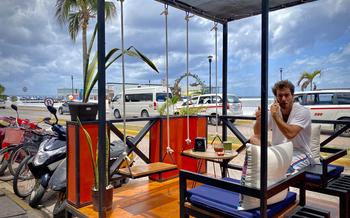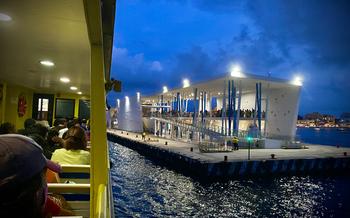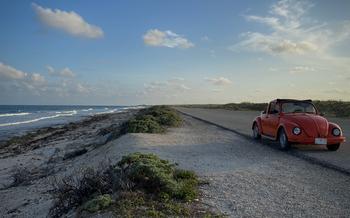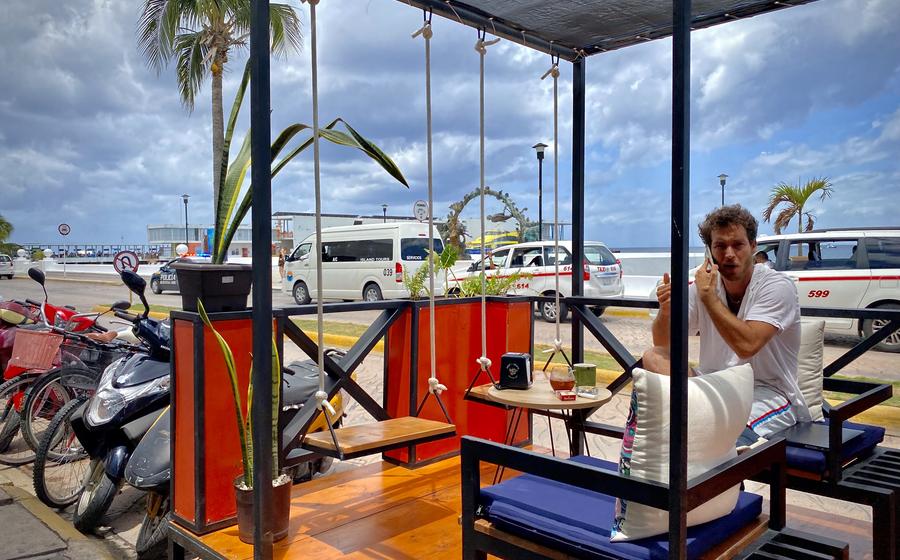
Stingray Beach
- Discovering Stingray Beach
- Location and Access to the Beach
- Origin of the Name
- History of the Site
- Ecological Importance
- Preparing for the Stingray Experience
- Embracing the Unique Encounter
- Booking a Guided Tour
- Interacting with Stingrays Safely
- Respecting the Environment
- Capturing Memories
- Exploring Surrounding Attractions
- Understanding Stingray Behavior
- Benefits of Stingray Encounters
- Overcoming Apprehension
- Stingray Beach Etiquette
- Local Culture and Traditions
- Supporting Local Communities
Discovering Stingray Beach
Nestled off the picturesque shores of Cozumel, Mexico, Stingray Beach beckons travelers with an immersive and awe-inspiring encounter with some of nature's most graceful creatures: stingrays. This pristine beach, with its crystal-clear waters and sandy shores, offers a unique opportunity to interact with these gentle giants in their natural habitat, creating memories that will last a lifetime.
Location and Access to the Beach
Stingray Beach is conveniently located on the southern coast of Cozumel Island, just a short distance from the bustling town of San Miguel de Cozumel. Visitors can easily reach the beach by taking a leisurely walk from the town center or by renting a bike or scooter to explore the island's scenic coastal roads.
Origin of the Name
The beach derives its name from the abundance of stingrays that frequent its shallow waters. These fascinating creatures, known for their distinctive wing-like pectoral fins, are a common sight at Stingray Beach, gracefully gliding through the crystal-clear waters and interacting with visitors in a safe and controlled environment.
History of the Site
The history of Stingray Beach is closely intertwined with the Mayan culture that once thrived on Cozumel Island. The Mayans held stingrays in high regard, considering them to be sacred creatures associated with the sea goddess Ixchel. They believed that stingrays possessed healing powers and would often visit the beach to seek their blessings.
Ecological Importance
Stingray Beach plays a crucial role in the marine ecosystem of Cozumel. The shallow waters and sandy bottom provide an ideal habitat for stingrays to feed, breed, and raise their young. The presence of stingrays also attracts a variety of other marine life, including colorful tropical fish, sea turtles, and dolphins, creating a vibrant and diverse underwater environment.
Preparing for the Stingray Experience
Ideal Time to Visit
The ideal time to visit Stingray Beach is during the dry season, which runs from November to April. During this time, the weather is generally sunny and dry, providing optimal conditions for swimming and interacting with stingrays. The water is also calmer during this period, making it easier to spot and approach the rays.
Recommended Dress Code
When visiting Stingray Beach, it is essential to dress appropriately for the occasion. Lightweight and comfortable clothing is recommended, as you will likely be spending most of your time in the water. Swimsuits, shorts, and rash guards are all suitable options. It is also advisable to wear water shoes or sandals to protect your feet from sharp coral or rocks.
Safety Guidelines
Safety should always be a priority when interacting with wild animals. Before entering the water, be sure to listen carefully to the safety guidelines provided by your tour guide or the beach staff. These guidelines will typically cover proper behavior around stingrays, such as avoiding sudden movements, not touching or grabbing the rays, and keeping a safe distance.
Interaction with Stingrays
Stingrays are generally gentle and curious creatures, but it is essential to respect their space and boundaries. When encountering a stingray, approach it slowly and calmly. Avoid making loud noises or sudden movements that might startle the ray. If a stingray swims towards you, remain calm and allow it to pass by. You can gently touch the ray's back or wings, but be sure to do so gently and with respect.
Embracing the Unique Encounter
At Stingray Beach, you'll not only have a thrilling encounter with these magnificent creatures but also gain a deeper understanding of their behavior, habitat, and conservation. Educational opportunities abound, with informative talks and presentations by marine biologists and conservation experts. Learn about stingray anatomy, their unique adaptations, and their vital role in the marine ecosystem. Discover their feeding habits, mating rituals, and social dynamics, and gain insights into their complex behavior.
The cultural significance of stingrays in the Mayan culture adds another layer to the experience. As you interact with these gentle giants, you'll sense the reverence and respect with which the Mayans regarded them. Stingrays were believed to possess spiritual powers, and their presence in the waters was seen as a sign of good fortune.
Beyond the educational and cultural aspects, the sensory experiences at Stingray Beach are simply unforgettable. The gentle touch of a stingray's velvety skin as it glides against your hand is a sensation unlike any other. Feel the thrill of their powerful yet graceful movements as they swim alongside you, and listen to the soothing sounds of their fins cutting through the water. Create lasting memories as you capture these magical moments with your camera or immerse yourself fully in the experience by leaving your devices behind and simply basking in the wonder of the moment.
Emotional connections are an integral part of the Stingray Beach experience. As you interact with these fascinating creatures, you'll develop a newfound appreciation for their intelligence, gentleness, and beauty. Leave behind your worries and anxieties as you connect with nature in a profound way. The tranquility of the beach, the gentle movements of the stingrays, and the awe-inspiring beauty of their underwater world will leave you feeling refreshed, rejuvenated, and deeply connected to the wonders of the natural world.
Booking a Guided Tour
Opting for a guided tour when visiting Stingray Beach offers a multitude of advantages. Guided tours provide a comprehensive and enriching experience, ensuring that you make the most of your time and interactions with stingrays.
Choosing the right tour operator is crucial for a fulfilling experience. Look for reputable companies with experienced and knowledgeable guides who prioritize safety, sustainability, and customer satisfaction. Reading reviews and recommendations from previous visitors can help you make an informed decision.
Inclusions and pricing vary depending on the tour operator and the duration of the tour. Typically, guided tours include transportation to and from your hotel, a guided snorkeling or swimming experience with stingrays, safety equipment, and professional instruction. Some tours may also offer additional perks such as snacks, drinks, or souvenirs.
The tour itinerary and duration are tailored to provide a balanced and immersive experience. Tours typically begin with a safety briefing, followed by an introduction to stingrays and their behavior. You will then be guided into the water, where you can snorkel or swim alongside these graceful creatures, observing them in their natural habitat. The duration of the in-water experience usually ranges from 30 minutes to an hour, providing ample time for interaction and exploration.
Interacting with Stingrays Safely
When interacting with stingrays, safety should be your top priority. Observe them in their natural habitat without disturbing their peaceful existence. Avoid touching or handling them unless instructed by a trained guide.
Observing Stingrays in Their Natural Habitat:
- Observe stingrays from a respectful distance to avoid startling or disturbing them.
- Maintain a calm and gentle presence to create a harmonious environment.
- Avoid sudden movements or loud noises that could cause them to retreat.
- Be patient and allow them to approach you on their terms.
Proper Feeding Techniques:
- If feeding is permitted, follow the instructions provided by your guide.
- Hold the food securely and offer it to the stingrays gently.
- Do not force the food into their mouths or attempt to hand-feed them.
- Be aware of the stingray's feeding habits and preferences to ensure proper nutrition.
Gentle Handling Practices:
- If you are allowed to touch the stingrays, do so gently and with respect.
- Avoid grasping or holding them tightly, as this can cause them discomfort.
- Handle them with care, supporting their weight evenly to prevent injury.
- Respect their personal space and allow them to move freely.
Avoiding Potential Hazards:
- Be mindful of the stingrays' sharp barbs located on their tail.
- Avoid stepping on or near the stingrays to prevent accidental injuries.
- Keep your hands and feet away from their mouths to prevent bites.
- If you feel threatened or uncomfortable, seek assistance from your guide immediately.
Respecting the Environment
Stingray Beach is a precious natural treasure that must be protected and preserved for future generations. Visitors have a responsibility to act responsibly and minimize their impact on the environment. Sustainable tourism practices are essential to ensure the well-being of stingrays and their fragile ecosystem.
Protecting Stingrays and Their Ecosystem
Stingrays are sensitive creatures that can be easily disturbed by human activities. It is important to avoid touching or harassing them, and to respect their natural behaviors. Feeding stingrays should only be done under the guidance of trained professionals, using appropriate food that does not harm their health.
Minimizing Human Impact
Visitors should be mindful of their actions and avoid creating unnecessary noise or disturbance. Littering and leaving behind trash can have detrimental effects on the marine environment. Proper waste disposal facilities should be used, and visitors should strive to leave the beach as pristine as they found it.
Sustainable Tourism Practices
Supporting local businesses that prioritize sustainability and conservation efforts is a great way to contribute to the protection of Stingray Beach. Tour operators that adhere to responsible practices, such as limiting group sizes and using eco-friendly boats, should be given preference.
Environmental Regulations
Local authorities have implemented environmental regulations to protect Stingray Beach and its inhabitants. These regulations may include restrictions on fishing, boat traffic, and other activities that could harm the ecosystem. Visitors should be familiar with these regulations and adhere to them to ensure the long-term sustainability of the beach.
Capturing Memories
Photography and videography guidelines
To capture the magic of your stingray encounter, it's important to follow responsible photography guidelines. Avoid using flash photography, as the bright light can disturb the stingrays and disrupt their behavior. Instead, rely on natural light or low-light settings to capture stunning shots without causing any harm.
Tips for taking stunning shots
When taking photos or videos, try to maintain a low profile and avoid making sudden movements that might startle the stingrays. Zoom in to capture close-ups of their graceful movements and unique features. Be patient and wait for the perfect moment, observing the stingrays' behavior before snapping a shot.
Respecting other visitors' experiences
Remember that other visitors are also seeking a memorable experience with the stingrays. Be mindful of their space and avoid blocking their views or interfering with their interactions. Maintain a respectful distance and take turns when feeding or interacting with the stingrays.
Sharing experiences responsibly
When sharing your photos and videos online, be mindful of the privacy of other visitors. Avoid posting images that might reveal the faces or personal information of others. Share your experiences responsibly, respecting the rights and privacy of everyone involved.
Exploring Surrounding Attractions
Beyond the enchanting encounters with stingrays, Cozumel offers a diverse range of attractions to enhance your vacation experience. Whether you seek adventure, relaxation, or cultural immersion, the island has something to offer every traveler.
Water-based Adventures: Embark on a snorkeling or scuba diving excursion to explore the vibrant underwater world of the Mesoamerican Barrier Reef, the second-largest coral reef system in the world. Discover the pristine coral formations, colorful marine life, and playful sea turtles that inhabit these crystal-clear waters.
Island Hopping: Take a day trip to one of the neighboring islands, such as Isla Pasión or Isla Mujeres, to experience their unique charm and offerings. Relax on secluded beaches, indulge in local cuisine, and immerse yourself in the laid-back vibes of these island paradises.
Cultural Exploration: Delve into the rich Mayan history and culture of Cozumel at the San Gervasio archaeological site. Wander amidst the ancient ruins, admire the intricate carvings and sculptures, and learn about the significance of this sacred site to the Maya civilization.
Culinary Delights: Savor the flavors of Cozumel's culinary scene by sampling fresh seafood dishes, traditional Mexican fare, and international cuisine. Visit local markets to discover an array of tropical fruits, spices, and handmade crafts. Indulge in the vibrant atmosphere of local restaurants and bars, where you can enjoy delicious meals while soaking in the island's lively ambiance.
Understanding Stingray Behavior
Stingrays are fascinating creatures with unique behaviors that offer insights into their underwater world. By understanding their body language and behaviors, visitors can enhance their experience and interact with stingrays responsibly. Stingrays communicate through a variety of body movements and postures. A relaxed stingray will have its wings spread out and its tail held straight. If a stingray is feeling threatened, it may arch its back, raise its tail, and rapidly flap its wings.
Regarding feeding habits, stingrays are bottom feeders, primarily consuming small fish, crustaceans, and mollusks. They use their keen sense of smell to locate food and their powerful jaws to crush and grind their prey. In terms of communication, stingrays communicate with each other through touch, body postures, and electrical signals. They use their electroreceptors to sense their surroundings and detect potential predators or prey.
Finally, stingrays are an important part of the marine ecosystem and face various threats due to human activities. Conservation efforts are crucial to protect stingray populations and their habitats. These efforts include habitat preservation, sustainable fishing practices, and public education programs. By understanding stingray behavior and supporting conservation initiatives, visitors can contribute to the protection of these magnificent creatures and ensure the long-term health of their marine environment.
Benefits of Stingray Encounters
Interacting with stingrays offers a multitude of benefits that extend beyond mere entertainment. These gentle creatures possess therapeutic and healing properties that can positively impact both physical and mental well-being. Spending time with stingrays has been known to reduce stress, promote relaxation, and enhance mindfulness. The rhythmic movements of their bodies and the gentle touch of their skin can create a sense of tranquility and serenity, allowing visitors to let go of worries and immerse themselves in the present moment.
In addition to their calming effects, stingray encounters can also boost confidence and self-awareness. Interacting with these fascinating creatures requires a combination of respect, care, and attentiveness. As visitors learn about stingray behavior and proper interaction techniques, they develop a sense of empowerment and self-assurance. Overcoming any initial apprehension or fear can lead to a profound sense of accomplishment and a newfound appreciation for these often-misunderstood animals.
Moreover, stingray encounters have the power to deepen our connection to the natural world. By observing stingrays in their natural habitat, visitors gain a greater understanding of marine ecosystems and the importance of protecting these delicate environments. The experience fosters a sense of responsibility and encourages visitors to become advocates for ocean conservation.
The benefits of stingray encounters are not limited to individuals; they also extend to the local communities that depend on stingray tourism for their livelihoods. The revenue generated from stingray encounters supports conservation efforts, creates jobs, and empowers local communities to protect their natural resources. By embracing sustainable tourism practices, visitors can contribute to the preservation of stingray populations and the well-being of the local people who call Cozumel home.
Overcoming Apprehension
Addressing common fears and misconceptions
For many, the idea of interacting with stingrays can be intimidating or even frightening. Common fears include the perception of stingrays as dangerous predators, concerns about their sharp barbs, and worries about being stung. However, it's essential to address these misconceptions to understand that stingrays are generally gentle and peaceful creatures. Their barbs are primarily used for defense and are rarely deployed unless provoked.
Strategies for managing anxiety
If you're feeling anxious about your stingray encounter, several strategies can help manage your anxiety. Deep breathing exercises, visualization techniques, and positive self-talk can help calm your nerves and promote a more relaxed state of mind. It's also helpful to focus on the educational and cultural aspects of the experience rather than solely on the physical interaction.
Encouraging positive attitudes
Approaching the stingray encounter with a positive attitude can make a significant difference. Instead of dwelling on fears, focus on the excitement and wonder of the opportunity to interact with these fascinating creatures. Remember that stingrays are highly intelligent and social animals, and the encounter can be a rewarding and transformative experience.
Building trust and confidence
Building trust and confidence are crucial for a positive stingray encounter. Start by observing the stingrays from a distance, allowing them to become accustomed to your presence. Gradually move closer, maintaining a calm and respectful demeanor. Avoid sudden movements or loud noises that might startle the stingrays. With patience and care, you can build a connection and trust with these gentle giants.
Stingray Beach Etiquette
Respecting Others' Space
Stingray Beach is a shared space, and it's essential to be mindful of other visitors' experiences. Avoid crowding around stingrays or blocking others' views. Give everyone a chance to interact with these gentle creatures and enjoy the unique experience.
Maintaining a Calm and Respectful Demeanor
Stingrays are sensitive to noise and sudden movements. To ensure a peaceful environment for both stingrays and visitors, maintain a calm and respectful demeanor. Avoid loud noises, shouting, or making sudden gestures.
Avoiding Loud Noises and Sudden Movements
Loud noises and sudden movements can startle stingrays and disrupt their natural behavior. To minimize disturbance, speak softly, move slowly and deliberately, and avoid splashing or making loud noises in the water.
Following Instructions from Guides and Staff
Stingray Beach guides and staff are experts in stingray behavior and safety. They are there to ensure everyone has a positive and safe experience. Always follow their instructions and advice. They will provide valuable insights into stingray behavior and help you interact with them respectfully.
Local Culture and Traditions
In the Mayan culture, stingrays hold a significant place, symbolizing grace, fluidity, and connection to the sea. Ancient Mayans believed that stingrays possessed spiritual powers and were messengers between the realms of the living and the departed. They were often depicted in Mayan art and mythology, representing the cycle of life, death, and rebirth.
The local culture of Cozumel is deeply intertwined with the sea and its inhabitants, including stingrays. Many local fishermen have a deep respect for stingrays, considering them to be protectors of the waters and bringers of good luck. Traditional Mayan fishing techniques often involve avoiding harming stingrays, as they are seen as guardians of the marine ecosystem.
Local legends and stories abound about stingrays, passed down through generations. Some tales speak of stingrays guiding lost fishermen back to shore, while others tell of stingrays helping to protect the island from storms and natural disasters. These stories reflect the deep connection between the local community and the natural world, and the reverence they hold for stingrays.
Cultural celebrations and events in Cozumel often incorporate elements related to stingrays. During the annual Carnival festivities, for instance, stingray costumes and decorations can be seen, paying homage to the cultural significance of these creatures. These celebrations provide an opportunity for locals and visitors to come together and honor the traditions and heritage of the island.
Supporting Local Communities
Stingray tourism in Cozumel has brought significant economic benefits to the local communities. By creating jobs and opportunities for local residents, it has empowered them to improve their livelihoods and contribute to the sustainable development of the region.
One of the remarkable aspects of stingray tourism in Cozumel is that it actively involves the local community. Many of the tour operators are family-run businesses, ensuring that the profits directly benefit the local economy. Additionally, local guides and staff are trained to provide visitors with an authentic and educational experience, sharing their knowledge about stingrays and the importance of their conservation.
Moreover, stingray tourism has encouraged the preservation of cultural heritage in Cozumel. By promoting understanding and appreciation for the local culture and traditions, it helps to keep alive the rich Mayan heritage that is so deeply intertwined with the island's identity. This, in turn, fuels a sense of pride and cultural preservation among the local community.
Overall, stingray tourism in Cozumel represents a model of sustainable tourism that not only provides visitors with an unforgettable experience but also actively contributes to the economic and cultural well-being of the local communities. By supporting local businesses and respecting the unique cultural heritage of the island, visitors can play a significant role in ensuring the long-term success and sustainability of stingray tourism in Cozumel.
